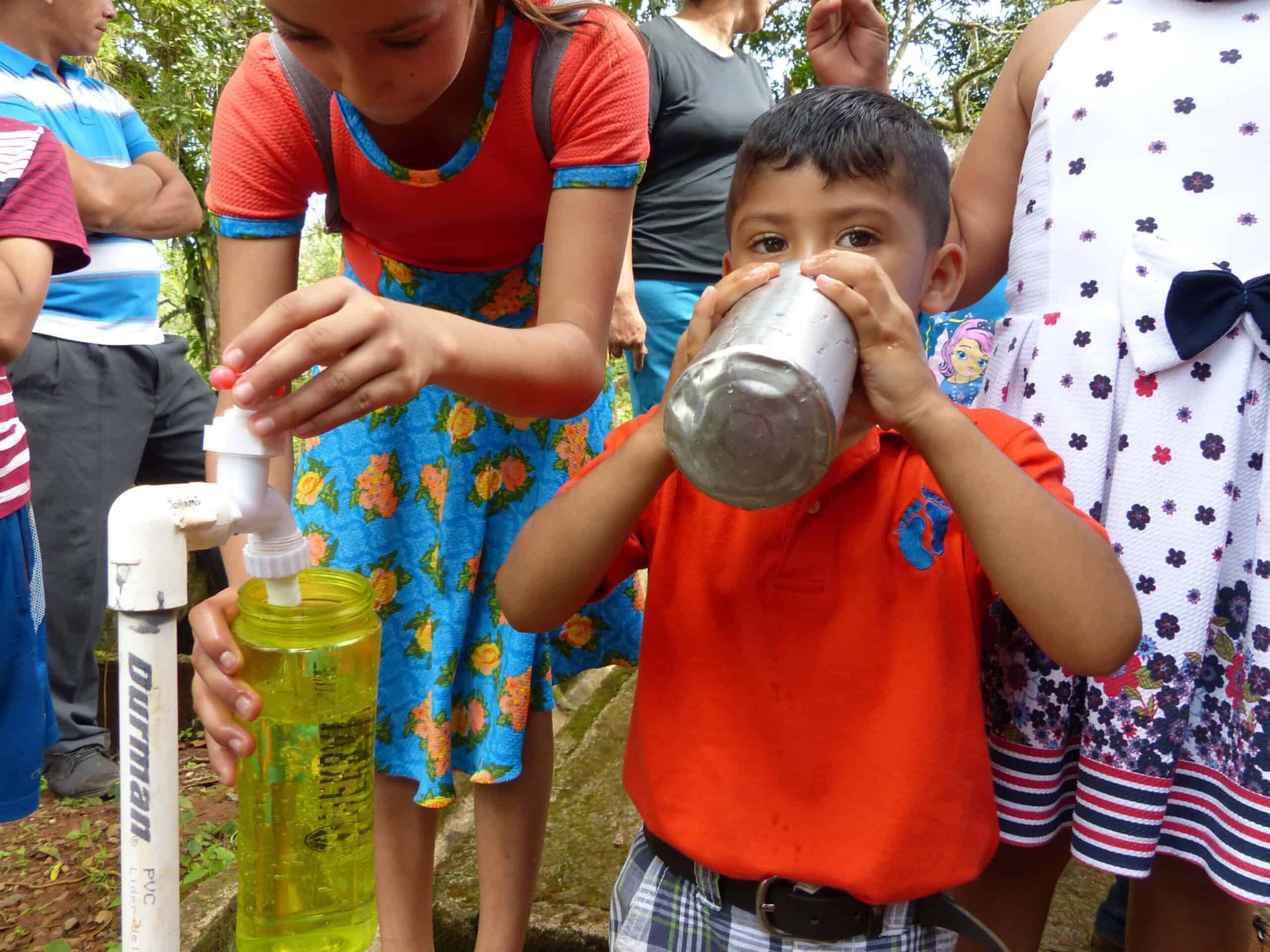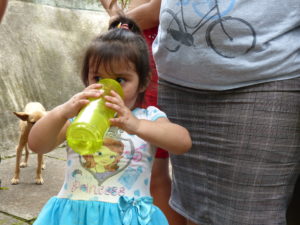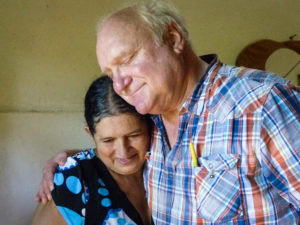
This article originally appeared in The Des Moines Register. Online on 12/19/2018 and in print on 12/23/2018.
By Jerry Perkins, Self-Help International Board Member
Los Angeles, Nicaragua — Thomas Wolfe wrote: “You can’t go home again.” I proved him wrong last month when I returned to Los Angeles, the rural Nicaraguan village that was home to me 47 years ago when I worked there as a Peace Corps Volunteer.
I didn’t recognize the place.
Most Peace Corps Volunteers yearn to return to the place where they spent part of their youth, trying — often against impossible odds — to make the world a better place. What I saw when I returned to Los Angeles last month was a flourishing little community that was unrecognizable from the raw and remote place I left in January 1972.

Kids in Los Angeles, Nicaragua, drink from a clean-water system supported by Self-Help International
Among the many changes I saw was a clean-water system supported by Self-Help International, an Iowa-based non-profit organization where I serve on the board of directors.
When Nora Tobin, the executive director of Self-Help, organized a trip to Nicaragua in November to review the organization’s programs, she included an inspection of the Los Angeles water system so I could revisit the place that gave me some of the most joyful and melancholy experiences of my life.
The half-day we spent in Los Angeles will definitely go into the joyous category because of the progress that the community has made since its founding in 1971. It has grown from 100 huts carved out of the rain forest to a town of approximately 200 families with a school, electricity, all-weather road and the clean-water system supported by Self-Help that has all but eliminated water-borne diseases.
The community’s growth has come despite a monstrous earthquake on Dec. 23, 1972, that destroyed much of the country’s capital of Managua and killed an estimated 10,000 people, a disastrous civil war from 1978-79 that wiped out an estimated 40,000 people, and Hurricane Mitch in 1999 that laid waste to much of the country’s infrastructure and agricultural resources in 1999.
To truly understand just how far Los Angeles has progressed, you need to know some background: After a volcano erupted on Nicaragua’s northwestern provinces, several hundred farms were buried under sand and ash. The Nicaraguan government sent the refugees to the newly created community of Los Angeles, which had been carved out of the rain forest in eastern Nicaragua with machetes and chain saws.
My job was to keep everybody alive by administering CARE and Catholic Relief Services food to the 100 or so families who were transplanted from northwest Nicaragua. Life was hard back then as the jungle was cut back and crops were planted. Houses were stick huts with sheet metal roofs provided by the government. The rain forest produced 235 inches of rainfall a year and it often came in heavy downpours that lasted for days. There was never enough food and the settlers were often hungry. Some of the children didn’t survive. It’s a memory that haunts me to this day.

Kids in Los Angeles, Nicaragua, drink from a clean-water system supported by Self-Help International.
In the years since, I have often recalled the quiet determination of the people of Los Angeles to lift themselves out of their trying circumstances. I’m sure the incredible progress that has been made in the 47 years since results from that grit and determination.
This was my second homecoming to Los Angeles. I had been sent to Nicaragua and El Salvador in 1983 by the Des Moines Register to report on the Contra War in Nicaragua and the civil war in El Salvador, both proxy Cold War battlegrounds that Register editors wanted me to explain to Iowans. They also thought it would be a good idea to take a sentimental journey back to a place where I once lived and worked.
In 1971, there was only a crude path cut through the jungle that was passable only on foot, by mule, or by a Caterpillar tractor.
Once, I had almost drowned in a muddy creek that cut across the road. Last November, we crossed the creek on a two-lane blacktop that is the equal to any farm-to-market county road in Iowa.
In 1971, it took 12 hours in a crowded bus to get from Managua to the end of the road, 12 miles from Nueva Guinea. From there, it was a three-hour mule ride to Nueva Guinea and another seven miles by foot or mule to Los Angeles.
Last November, the road to Los Angeles from Nueva Guinea was rutted and bumpy but passable for vehicles like the Self-Help pickup truck we rode in.
Nor is the paved road the only sign of progress. There is a classy big, blue, new hotel in Nueva Guinea and a Catholic church now stands at what used to be the end of a runway that was carved out of the rain forest so that Lockheed C-130 Hercules four-engine turboprop military transport aircraft from the Panama Canal Zone could deliver the refugees to Nueva Guinea.
All of the changes left me feeling disoriented, as if I had arrived at a completely different place than the one I had come to know so intimately as a 23-year-old Peace Corps Volunteer. I struggled to identify old landmarks such as the runway, which is now covered by storefronts and houses.
The disorientation continued when we arrived in Los Angeles. Back in 1971, the rain forest had been clear-cut to open up the area for the refugees. In 1983, practically none of the vegetation had regrown among the houses and there were pastures instead of tall stands of jungle trees.
When I returned in November, however, there had been considerable regrowth of the jungle canopy. The residents of Los Angeles have established a rain forest preserve in the hopes that they can attract eco-tourism. As I tried without success to figure where I was, the regrown greenery served only to confound my sense of place.
What I most wanted to do in Los Angeles was reconnect with the family of Jesus and Herminia Escoto, who fed me while I was in Los Angeles. They became my second family while I lived there. They provided not only my meals, but also the loving grace of a family that worked together to make a place for themselves in the often-forbidding environment of the rain forest.

Former Register farm editor Jerry Perkins visits with Nicaraguan woman Adilia, who he met in the early 1970s.
Sadly, Jesus and Herminia had passed away eight and six years ago, respectively, I was told. But their daughter, Adilia, and two sons, Victor and Ernesto, still lived in Los Angeles.
After we inspected the water system and had a lunch of rice, beans and chicken, we drove down the road to where Adilia lives. She was a little girl with a baby brother on her hip when I last saw her. Today, she’s a 56-year-old mother of seven.
While we reminisced about the time I had spent in Los Angeles, her two brothers, Victor and Ernesto, stopped by Adilia’s house and they affectionately recalled some of the stories they still tell about “El Meester,” my nickname in Los Angeles.
All too soon, it was time to go. I hugged Adilia, and Ernesto put his hands on my head, blessing me and praying for my safe journey.
I left feeling sad from having to say good-bye, but it was good to know I would always be welcome in Los Angeles, Nicaragua.
Jerry Perkins is a member of the board of directors of Self-Help International. He was the farm editor of the Des Moines Register from 1993-2008.

Powered by Wapiti Digital #servetheherd
This is my rich text.
This is more rich text.
I am a list
Lists are cool